–
螳螂六合棍
MANTIS LIUHE STAFF
黃漢勛著
by Huang Hanxun [Wong Honfan]
[published in Hong Kong within 武術雜誌 Chinese Boxing Magazine over the course of thirty-six issues (#298–#333) from Dec 8, 1956 to Aug 10, 1957]
[translation by Paul Brennan, Jan, 2021]
–
六合棍序
PREFACE
中國拳術有六合門一派,人或疑吾螳螂門中之六合棍或六合雙刀等卽為該門之技術,查上述兩技皆為螳螂門中著名器械之一,蓋六合者採天地陰陽正氣者,是為六合之氣,前人之所以以此命名者或寓意於此也。
六合棍乃包括長短、雙單、左右之良佳棒法,吾人習此必先注意者曷為圈、點、劈、挑,諸法,否則便是空有其表之呆板棍法耳!總技貴有恒心與苦練,苟能實事求事虛心就學,何患乎不成功耶!序云乎哉。
黃漢勛于餘生書齋丙申孟冬中浣
Among Chinese boxing arts is the Liuhe [“six unions”] system. People sometimes think that the Mantis curriculum’s Liuhe Staff and Liuhe Double Sabers are sets from the Liuhe system, but some investigation reveals that they are actually famous weapon sets from the Mantis art. “Liuhe” refers to the balance of the passive and active energies of the universe [the six “unions” being north and south, east and west, up and down], and therefore previous generations adopted this name to allude to this concept.
Liuhe Staff contains superb techniques of both long range and short range, double-hand grip and single-hand grip, left-side position and right-side position. You first have to master the basic techniques of coiling, tapping, chopping, carrying, and so on, otherwise you will just end up with a bunch stiff and superficial movements. Gaining any skill requires perseverance and hard work. As long as you can strive for what is practical and realistic, and be open-minded to learning, you are sure to succeed.
- written by Huang Hanxun at the War Survivors Studio, 33rd year of the cycle, middle ten days of the 1st month of winter [i.e. mid Nov, 1956]
–
第一式:背立舉刀
Posture 1: STANDING WITH YOUR BACK TURNED, RAISING A SABER
說明:
Explanation:
假定我擇西方作此棍之起點,應面北背南左西右東而立,雙手握棍之末端,左陽手曲肘微入,右陰手曲肘使與左手齊一其方位,兩手之中間距離約六七華寸,棍之鋒端高舉至本身頭部以上,目注視右東方以俟棍法之開始如圖一。
Stand in the western part of the practice space facing to the north, the south behind you, the west to your left, east to your right, with both hands holding the end of the staff apart two thirds of a foot apart, the center of your left hand facing upward, the center of your right hand facing downward, your elbows bent, the tip of the staff higher than your headtop. Your gaze is to the right toward the east. (This is a position of readiness to act.) See photo 1:
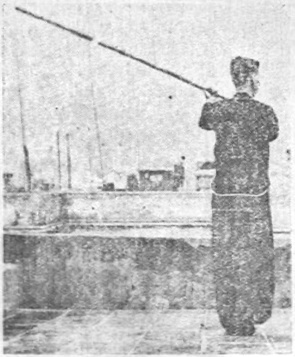
功用:
Application:
棍尚未開始,動作故無功用可言,但為蓄勢佈局之開端,練之者幸毋以疎忽或漫不經意之意出之,蓋佳劣常繫於此細節之中也。
Because movement has not yet begun, this posture therefore has no actual application to speak of. However, it is a position of storing power in readiness, and so I hope you will not neglect it or consider it to be of little worth.
第二式:崩打一棒
Posture 2: CUDGELING WITH AN AVALANCHE STRIKE
說明:
Explanation:
循上式,先將右脚向東開出一步,以成右登山式,棍僅藉右手握持而向地打下,而左手離棍後則化掌架於頭上,當棍到地時,必有甚响喨之聲音,而棍亦被反彈力所跳起矣,切勿使棍再有觸地病,否則便有毫厘之差矣,如第二圖。
Continuing from the previous posture, your right foot steps out to the east to make a right mountain-climbing stance as your right hand sends the staff striking downward to the ground, your left hand letting go and propping above your head as a palm. (When the staff hits the ground, it has to provide a resounding crack. The bounce from the impact should also lift it right back up. Allow it to rise when it does and do not let it fall back down to hit the ground again.) See photo 2:
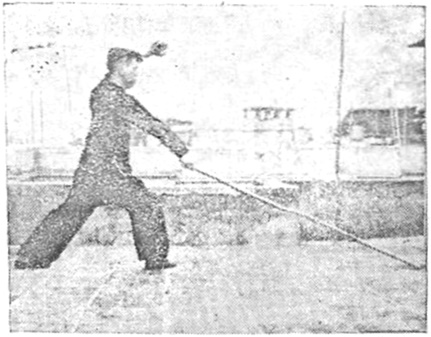
功用:
Application:
當我上式高舉棍時,已是凖備由上擊落彼方矣,如彼自我中下路擊來,我卽利用居高臨下之優勢而用崩打一棒之法,疾殺來械也。
With the staff raised high in the previous posture, I am already prepared to send it striking downward, so if an opponent attacks my middle area or lower area, I take advantage of my position of “having the high ground” by using this avalanche technique to smash down his weapon.
第三式:跨虎軋槍
Posture 3: SITTING-TIGER STANCE, CRUSHING A SPEAR
說明:
Explanation:
循上式,不俟打下之棍再次打落地卽伸左手向前握回原棍如「過渡式」甲,
Continuing from the previous posture, without letting the staff drop and tap against the ground a second time, [your right hand pulls it back as] your left hand goes forward and grabs it again. See photo 3a:

再退右脚,拉左脚以成左跨虎步,棍由曲手之勢,向前伸直彈軋而出,如「定式」。
Then your right foot retreats and your left foot pulls back to make a left sitting-tiger stance as your arms bend to retract the staff and then send it snapping forward, performing a crushing action. See photo 3b:
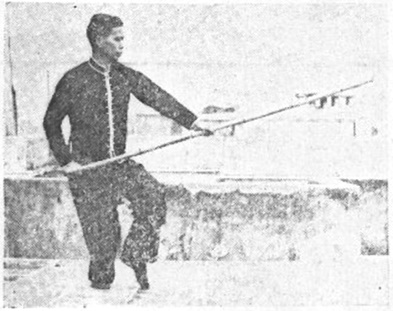
功用:
Application:
我棍旣已殺落,中上路必感空虛矣,彼若能躱去我崩打之棒,當必偷棍自我中上搶入矣,於是我先退卸之,再用棍蓋其械之上而彈軋之,斯為棍法專要法門,習之者宜萬分留意焉。
Once I have smashed down with my staff, my middle area and upper area will be open. If the opponent is able to dodge my avalanche strike, he is sure to try to sneak in an attack to my middle or upper area, so I retreat and then use my staff to cover the upper section of his weapon and crush it down with a snap. This technique demands precision, and so it has to be given great attention.
第四式:斜勢軋槍
Posture 4: DIAGONAL POSTURE, CRUSHING A SPEAR
說明:
Explanation:
循上式,右後脚先向西北斜方撒退,左脚循而放平,使成斜左登山步,棍先貼胸前,如「過渡式」
Continuing from the previous posture, first your right foot retreats diagonally to the southwest, your left foot coming down fully, your feet making a left mountain-climbing stance as you bring in the staff against your chest. See photo 4a:
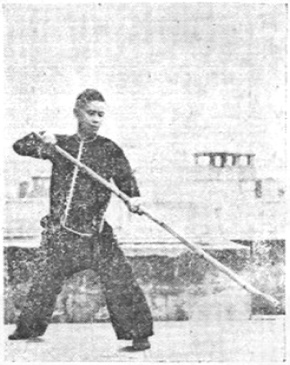
再向東南斜方軋出,棍與身步雖成斜向,然其棍與步俱正其子午也,如「定式」。
Then you send out the staff diagonally toward the southeast with a crushing action. (Although the staff, your body, and your step are moving diagonally, the staff finishes exactly along the line that your feet are making.) See photo 4b:

功用:
Application:
彼械為我正面軋去,乃改變而從我斜方攻來,我亦斜步迎之,再用軋槍法以封閉來械,我旣佔臨下之勢,使其難再為害於吾矣。
Once the opponent’s weapon has been crushed away, he changes position and attacks me from an angle, so I too step diagonally to match his angle and again use the technique of “crushing a spear” to seal off his weapon. By occupying the high ground once again, I make it difficult for him to harm me.
第五式:扑腿低撇
Posture 5: REACHING-LEG STANCE, SWINGING BELOW
說明:
Explanation:
循上式,先將右後脚拍貼於左前脚,再成向東正線,左前鋒往後手收貼於右手,如「過渡式」甲,
Continuing from the previous posture, first your right foot stomps down next to your left foot, your feet standing in an eastward line [i.e. toes pointing toward the south], as your left hand goes forward next to your right hand. See photo 5a:
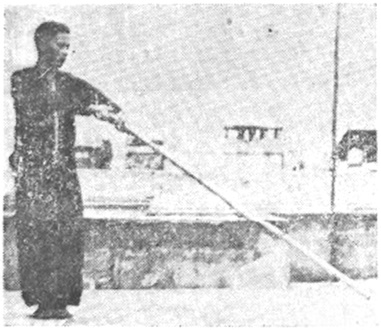
再將左脚向前東方開出,以成左扑腿式,右手向前開,右手往後拉,使棍端橫撇於左下方,右手高提如「定式」。
Then your left foot steps out forward toward the east to make a left reaching-leg stance as your right hand holds its end of the staff forward, lifting high, and your left hand pulls to the rear, causing the staff tip to swing across to the lower left. See photo 5b:

功用:
Application:
彼再走我左方,用械取我下路,我乃先以扑腿法低勢迎之,再以棍低撇,使來械被撇而有機會反擊其他處也。
The opponent now moves over to my left side and tries to attack my lower area, so I engage him by getting into a reaching-leg stance and using my staff to swing across below, thereby deflecting his weapon and giving me an opportunity to counterattack.
第陸式:提棍點膝
Posture 6: LIFTING THE STAFF, TAPPING TO THE KNEE
說明:
Explanation:
循上式,左右脚不變原來位置,祗由扑腿式轉為左登山式,左右手同時持棍提起,再向下點落,經由膝部而至脚背部而止,如「定式」。
Continuing from the previous posture, with your feet staying where they are, switch to a left mountain-climbing stance as your hands lift the staff and then tap it downward, following through from the opponent’s knee area to also reach the top of his foot. See photo 6:
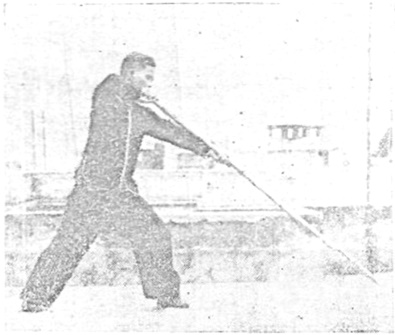
功用:
Application:
我旣撇去來械,當卽採取反攻,乃卽化扑腿為登山步,致用棍端點落彼膝部,膝部位置至為細小,點之至不容易,以是而需練時有一定定點,不可糊亂引之,否則便成盲拳亂棒之類矣。
Having swung aside the opponent’s incoming weapon, I now seek to counterattack, so I switch to a left mountain-climbing stance and send the tip of my staff to his knee with a tapping action. Because the knee is a small target, it is not easy to hit with precision, and so you should spend time practicing hitting fixed targets. You must not get sloppy in your training, or you will develop a tendency toward “blind fists, chaotic staff”.
第七式:走跳單接
Posture 7: HOP FORWARD, SINGLE UPWARD SWING
說明:
Explanation:
循上式,進右脚,以成右跨虎步,兩手仍舊持棍,棍由下向上舉,乃「過渡式圖」
Continuing from the previous posture, your right foot advances to make a right sitting-tiger stance as the staff rises up from below, both hands still holding the staff. See photo 7a:

再乘虛步而後前跳出,當跳越時,左手離開握棍,餘剩右手持棍端,棍由下轉上繞成一匝,是為單接,為『定式圖』
Then make use of the momentum of your right foot advancing by hopping forward, and while you hop, your left hand lets go of the staff, leaving your right hand holding the end of the staff as it arcs upward from below to make a full circle. See photo 7b:
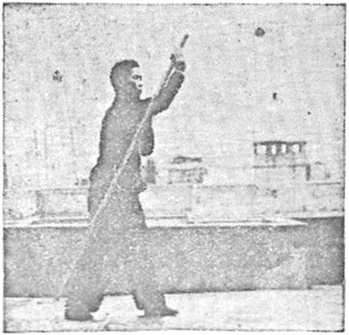
功用:
Application:
彼方姿勢凌厲或彼衆我寡,則我必須以絕大犧牲決決心求與彼一搖,於是僅以單手使棍俾增加其速度乃力道也。
The opponent’s attack is fierce, or I am outnumbered by opponents, therefore I have must be willing to disengage in order to engage, meaning holding on with only one hand as a means of increasing the speed of my staff.
按:此為動式,須留心連珠,方不致錯誤乃有負斯着之環境也。
(Note: This is only a transitional posture, and so it is necessary to flow right into the following posture in order to keep from violating the purpose of this one.)
第八式:收棍舉刀
Posture 8: WITHDRAW THE STAFF, RAISING THE SABER
說明:
Explanation:
循上式,原步不變,祗將棍由下復上,由右方下方轉過左上方,再以左手重握棍之中段,登山式則由小轉大,目視右前方,為「定式」圖。
Continuing from the previous posture, with your stance not changing, the staff continues upward from below, going from the lower right to the upper left, and then your left hand again grabs the middle section as you continue forward into a right mountain-climbing stance. Your gaze is forward to the right. See photo 8:
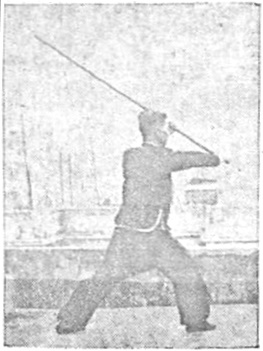
功用:
Application:
單手挑棍者,僅求背城借一耳,若一擊落空,則我危險甚矣,於是每凡單接或雙接之後,例必有收棍之勢以俟敵也。因其高舉而似大刀之勢,故以是得名焉。
Doing a carrying technique one-handed is a somewhat desperate act, meaning that if I miss, I would be in a perilous situation, and so after using the upward swinging technique, I have to withdraw my staff to prepare for whatever the opponent may do next. This posture feels similar to a position commonly adopted with the large saber, hence the name of the posture.
第九式:崩打一棒
Posture 9: CUDGELING WITH AN AVALANCHE STRIKE
說明:
Explanation:
循上式,原步不變,其他與第二式同。
Continuing from the previous posture, with your stance not changing, perform the same action as in Posture 2. See photo 9:

功用:
Application:
與第二式同。
Same as in Posture 2.
第十式:單提棍法
Posture 10: LIFTING THE STAFF WITH ONE HAND
說明:
Explanation:
循上式,左右脚不變原來位置,僅由右登山轉為左登山式,將崩下之棍曲右肘往上向左提起,左手握拳置於右肩部,棍平中而端鋒畧高,如「定式」。
Continuing from the previous posture, with your feet staying where they are, your stance simply switching from a right mountain-climbing stance to a left mountain-climbing stance, your right hand lifts the staff up to the left side, the elbow bending, as your left hand forms a fist and is placed at your right shoulder, the staff almost parallel with the ground, the tip slightly higher. See photo 10:

功用:
Application:
此提棍式與下式之老僧穿衣,俱為棍中之少見者,亦卽寓有特殊之妙用焉,單手指棍者,取其快速耳!而左手旣近棍而偏不握者,是視對方用力多少而定也,且在提棍之頃刹,尤能直手標向敵方,標然轉身變式者亦知便利也。
This posture and the following posture are both rarely seen within staff sets, and yet they are rather wonderful, pointing the staff with just one hand and striving to move with quickness. My left hand gets near the staff, but does not grab it. I am now observing the strength of the opponent, for in the moment when I have lifted the staff, I am perfectly placed to be able to suddenly dart it straight out toward him and then turn my body and move away from him.
第十一式:老僧穿衣
Posture 11: OLD MONK PUTS ON HIS ROBE…
說明:
Explanation:
循上式,提起左脚用力再踏下,當踏步之時右後脚後面前轉過西方為右登山式,同時棍已加諸肩上矣,左拳更乘勢伴過東方,同時往後注視如「定式」。
Continuing from the previous posture, your left foot lifts and stomps down, then your right foot steps toward the west, passing in front of you [as your body turns around leftward], to make a right mountain-climbing stance, the staff being placed on top of your shoulders [as your right hand pulls it toward the west], your left fist correspondingly extending toward the east. See photo 11:

功用:
Application:
其架於肩上如担物狀者,純為誘惑性之作用,若妄進者每易受其轉身標棒之襲擊與及走跳單接或雙接之挑擊,表面觀之乃屬呆滯,惟要研求之當可發現其妙處所在也。
The act of putting the staff on my shoulders like a yoke is simply meant to lure the opponent in. If he rashly advances, it would then be easy for me to turn my body and suddenly attack, for instance with the carrying technique in HOP FORWARD, DOUBLE UPWARD SWING [Posture 13]. This posture appears on the surface to be foolish, but examine it more deeply and you will discover its ingenuity.
第十二式:穿衣疾走
Posture 12: … AND SWIFTLY FLEES
說明:
Explanation:
循上式,原式不變,以竄跳方式疾走往西方,惟走時全身俱動乃容易引起棍之跳動,但能便棍不為牽動斯為合適矣。如「定式」。
Continuing from the previous posture, with your position not changing, you scurry away with a hop toward the west [left foot moving, then right], your whole body being drawn along by the movement of the staff pulling back rather than the staff following the movement of your body. See photo 12:

功用:
Application:
與上十一式相同。
Same as in Posture 11.
第十三式:走跳雙接
Posture 13: HOP FORWARD, DOUBLE UPWARD SWING
說明:
Explanation:
循上式,先將右吞塌步轉過左方以成左登山之勢,棍由肩部向身傍斜斜殺落,如「過渡式」甲,
Continuing from the previous posture, first shift to the left to make a left mountain-climbing stance as the staff leaves your shoulders and swings down diagonally beside your body. See photo 13a:
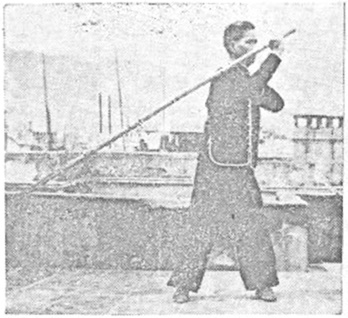
再跳起將棍挑出,如「過渡式」乙,
Then hop forward as the staff goes out with a carrying action. See photo 13b:

當跳起時復將棍轉後方,比之第七式之單接是多轉一圈者,如『定式』。
Once you hop, let the staff arc again to the rear to then swing upward again. (This technique is similar to the single upward swing of Posture 7, but with an additional circle.) See photo 13c:

功用:
Application:
我用接連之蹤跳挑法,使對之者,實難予招迎也。
I use a method of continuously carrying while hopping to make it difficult for the opponent to engage.
第十四式:收棍舉刀
Posture 14: WITHDRAW THE STAFF, RAISING THE SABER
說明:
Explanation:
「俱與第八式相同」循上式,原步不變,祇將棍由下復上,由右下方轉過左上方,再以左手重握棍之中段,登山式則由小轉大,目視右前方,如「定式」。
Continuing from the previous posture, with your stance not changing, the staff continues upward from below, going from the lower right to the upper left, and then your left hand again grabs the middle section as you continue forward into a right mountain-climbing stance. Your gaze is forward to the right. (The movement is the same as in Posture 8.) See photo 14:

功用:
Application:
單手挑棍者,僅求背城借一耳,若一擊落空,則我危險甚矣,於是每凡單接或之後,例必有收棍之勢以俟敵也,因其高舉而似大刀之勢,故以是得名。
Doing a carrying technique one-handed is a somewhat desperate act, meaning that if I miss, I would be in a perilous situation, and so after using the upward swinging technique, I have to withdraw my staff to prepare for whatever the opponent may do next. This posture feels similar to a position commonly adopted with the large saber, hence the name of the posture.
第十五式:圈轉劈軋
Posture 15: COILING INTO A CRUSHING CHOP
說明:
Explanation:
循上式,原步不變,棍自上劈落至平,為「過渡式」用,
Continuing from the previous posture, with your stance not changing, the staff chops down from above to be parallel with the ground. See photo 15a:
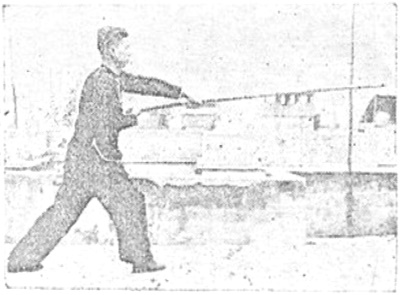
再將棍直落轉向右後方,如「過渡式」乙,
The staff continues downward and arcing to the right rear. See photo 15b:

再進右脚以成跨馬式,棍自後向前跟馬殺落,合三式不停以至如『定式』圖。
Then your left foot advances to make a horse-riding stance as you send the staff smashing down forward from behind. (These three movements are to be performed as a continuous flow without any pauses between them.) See photo 15c:
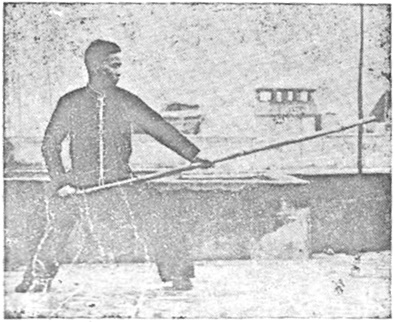
功用:
Application:
來械自我中路突入,我卽用棍自舉刀式殺落彼再漏下攻我之下三路,我卽隨械轉落,使來械無突入機會,再進馬將棍轉過前方自上擊落,使彼上,中,下,三路,俱受我之威脅焉。
The opponent suddenly attacks my middle area, so I send my staff smashing down from above, but he then takes advantage of the gap below and attacks my lower area, so I follow his movement by sending my staff arcing downward, giving his weapon no chance of getting near me, then advance while rolling my staff over and striking forward and downward from above, thereby threatening all three of his areas with attack (upper, middle, lower).
第十六式:提棍點膝
Posture 16: LIFTING THE STAFF, TAPPING TO THE KNEE
說明:
Explanation:
循上式由跨虎式轉為左登山式,高峯右手以便棍鋒向前點落,與第六式同,為『定式』。
Continuing from the previous posture, switch to a left mountain-climbing stance as your right hand rises high to send the staff tip tapping downward. (The movement is the same as in Posture 6.) See photo 16:

功用:
Application:
(與第六式相同)
Same as in Posture 6.
第十七式:跨步斜攔
Posture 17: CROSSING STEP, DIAGONAL BLOCK
說明:
Explanation:
循上式,原步不動,右手離開,招之末端,當離開時順手將末往前一送俾棍向出,右手垂下如「過渡式」甲,
Continuing from the previous posture, with your feet staying where they are, your right hand lets go, allowing your left hand to roll the staff over so that the rear tip goes forward, your right hand hanging down. See photo 17a:
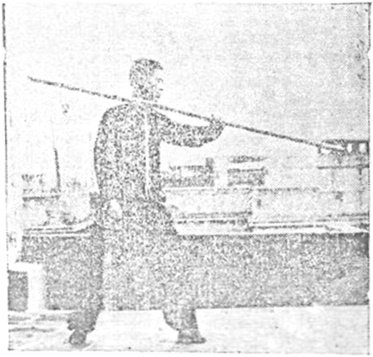
再用右手握棍,其握處乃左手之上,當右手握得時左手乃向棍末處順落,以成如「過渡式」乙,
Then your right hand grabs the staff next to your left hand and your left hand slides to the forward tip. See photo 17b:

再左右脚交換其本來位置,惟交換時是以跳圈法行之,右手由後上反向前下橫殺過左斜方,如『定式』。
Then your feet switch places with a hop, your right foot stepping across to make a right mountain-climbing stance as your right hand sends the staff smashing across diagonally downward to the left. See photo 17c:

功用:
Application:
此乃換步,換手,換棍之奇着,使對方失去目標,雖有追擊之心,亦等於零而已!棍與手步俱同時運用,方不至有呆滯之態也。
This technique of switching feet, switching hands, and turning the staff over causes the opponent to lose his target, and no matter how intent he is, his attack is nullified. With the feet, hands, and staff all moving in unison, there is no sluggishness in the movement.
第十八式:跨步斜攔
Posture 18: CROSSING STEP, DIAGONAL BLOCK
說明:
Explanation:
循左式,先原步不動,再放開左手,當放開時將棍端用力推前,如「過渡式」甲,
Continuing from the previous posture, with your feet staying where they are, your left hand lets go, allowing your right hand to roll the staff over so that the rear tip goes forward, your left hand hanging down. See photo 18a:
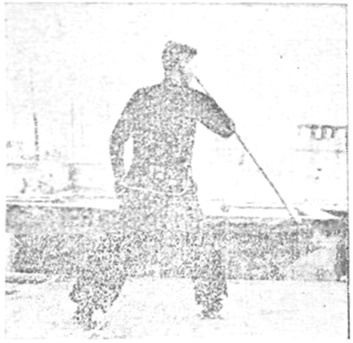
再復用左手握回右手之上,使右手再握持棍之末端,如「過渡式」乙,
Then your left hand grabs the staff, going next to your right hand, and your right hand slides to the forward tip. See photo 18b:

再全身用換步之躍跳法,亦卽跨步也,仍為右登山式,棍自後反向前斜下方攔出,如「定式」
Then your feet switch places with a hop, your left foot stepping across to make a left mountain-climbing stance as your left hand sends the staff smashing across forward and diagonally downward to the right. See photo 18c:

功用:
Application:
與上式合成一左一右一正一反之勢,合行之便有連環之妙矣。
This posture is to be combined with the previous posture, the technique being performed to the left and right in a continuous flow.
第十九式:偷步明封
Posture 19: STEALTH STEP, CLEANLY SEALING
說明:
Explanation:
循上式,右脚自後偷往前方,棍由下斜抬起往上,使攔住身體之各部,如「過渡式」
Continuing from the previous posture, your right foot advances with a stealth step, going behind your left foot, as the staff lifts diagonally upward from below, thereby blocking off all three sections of your body. See photo 19a:

再開左脚進前以成左登山步,棍向正方盡力軋出,如『定式』
Then your left foot advances to make a left mountain-climbing stance as the staff goes forward with a crushing action. See photo 19b:
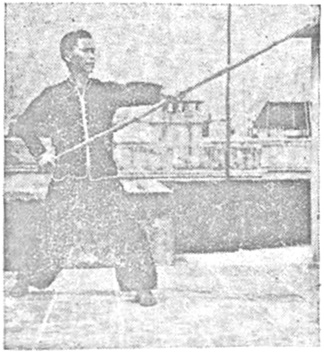
功用:
Application:
彼欲俟機反攻,我乃先偷步以備易於進前,再以棍攔拒之,彼眞欲來時,我則明封之,斯卽暗入明出之法也。
While the opponent waits for the right moment to counterattack, I do a stealth step in readiness to advance upon him easily while using the staff to block anything that comes. Once he decides to attack, I am thus able to cleanly seal it off. This is a method of “entering shade and then emerging into sunlight”.
第二十式:扑腿低撇
Posture 20: REACHING-LEG STANCE, SWINGING BELOW
說明:
Explanation:
循上式,先將右後脚拍貼於左前脚,再成向東正線,左前鋒往後收手貼於右手,如「過渡式」甲,
Continuing from the previous posture, first your right foot stomps down next to your left foot, the toes of both feet pointing toward the south, as your left hand goes forward next to your right hand. See photo 20a:

再將左脚向前東方開出,以成左扑式,右手向前開,右手往後拉,使棍端橫撇於左下方,右手高提如「定式」。
Then your left foot steps out forward toward the east to make a left reaching-leg stance as your right hand holds its end of the staff forward, lifting high, and your left hand pulls to the rear, causing the staff tip to swing across to the lower left. See photo 20b:

功用:
Application:
彼再走我左方,用械取我下路,我乃先以扑腿法低勢迎之,再以棍低撇,使來械被機而有機會反擊其他處也。
The opponent now moves over to my left side and tries to attack my lower area, so I engage him by getting into a reaching-leg stance and using my staff to swing across below, thereby deflecting his weapon and giving me an opportunity to counterattack.
第二十一式:纏攔囘身
Posture 21: COILING BLOCK WHILE RETREATING
說明:
Explanation:
循左式,原步不變,棍由後斜方拉過前上方,如「過渡式」甲,
Continuing from the previous posture, with your stance not changing [apart from rising up], pull the staff diagonally forward and upward from behind. See photo 21a:
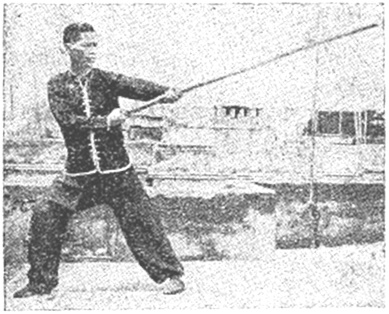
再以左脚由前偷過後方,棍由前上撥過左後斜方,如「過渡式」乙,
Then your left foot does a stealth step, passing in front of your right foot, as you send the staff deflecting diagonally to the left rear. See photo 21b:
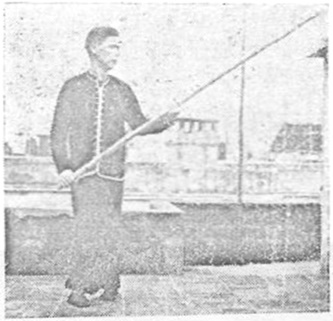
再退右脚以成左吞塌步棍再由後自下反向上正方抽起,以成如『定式』。
Then your right foot retreats to make a gulp & sink stance as you return the staff upward from below, pulling it back. See photo 21c:
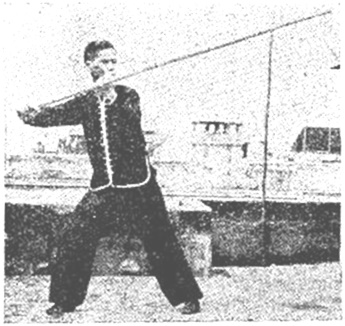
功用:
Application:
此式之返身乃用連蹤帶跳方式而走,棍用上下挑攔之法,極盡遮攔架格之能事,彼雖集多人用械追來,吾亦無所畏也。
This technique involves retreating with continuous hops while the staff goes up and down with actions of blocking [to the left] and carrying [to the right]. Such skillful blocking enables me to fend off multiple weapon-wielding attackers without panicking.
第二十二式:纏攔囘身
Posture 22: COILING BLOCK WHILE RETREATING
說明功用:
Explanation & application:
俱與二十一式同
Same as in Posture 21. See photos 22a–22c:



第二十三式:纏攔囘身
Posture 23: COILING BLOCK WHILE RETREATING
功用說明:
Explanation & application:
(俱與上廿一、廿二式同)
Same as in Postures 21 & 22. See photos 23a–23c:



第二十四式:中平軋槍
Posture 24: STANDING STABLY, CRUSHING A SPEAR
說明:
Explanation:
循上式,反左吞塌步,為左登山式,棍由兩手曲肘轉為向直線伸出,使棍勢由曲而直,在此一曲一伸之間卽發出彈性之作用,如『定式』。
Continuing from the previous posture, switch into a left mountain-climbing stance as your arms bend and then extend, sending the staff straight out with a crushing action, the bending and extending of your arms causing the staff to shoot out with a snapping effect. See photo 24:
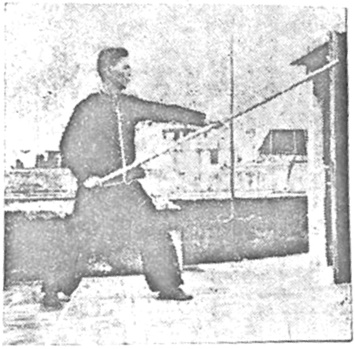
功用:
Application:
(與第十九定式同)
Same as in Posture 19.
第二十五式:漏棍圈棒
Posture 25: SLIPPING & COILING
說明:
Explanation:
循上式,右後脚自後由圖前進前以成前偷步式,棍鋒由上斜圈過左後方,圈形愈小愈佳,能使兩眼不及見者迨已登峯造極矣,但過渡式僅及圈至之半耳!如「過渡式」,
Continuing from the previous posture, your right foot advances with a stealth step, passing behind your left foot, as you draw a small counterclockwise circle with the forward tip of the staff (up, left, down, right), ideally small enough to be barely noticeable. (The photo shows only the first half of this circle [up, left, and starting its way down].) See photo 25a:

再循棍端圈之至平直則全圈已成矣,如『定式』圖。
Finish the circle holding the staff straight out so that it is parallel with the ground. See photo 25b:

功用:
Application:
彼棍欲直削而入,或以重械力壓我棍,我卽以此旣漏且圈之法反而圈殺彼之先鋒手,旣不必與之鬥力,又可連消帶打,相鬥之善其莫於此手。
The opponent tries to cut straight through in order to attack me, or tries to forcefully press down my staff, so I use this slip & coil technique to circle back around his weapon and then smash his front hand. It is not necessary to struggle against him, for I can go along with what he is doing in order to dissipate it and then let the movement lead right back into attacking him. Techniques of fighting against an opponent are inferior to techniques such as this one.
第二十六式:中平軋槍
Posture 26: STANDING STABLY, CRUSHING A SPEAR
說明:
Explanation:
進後左脚以成左登山式,棍與十九式同樣軋出,如『定式』。
Your left foot advances to make a left mountain-climbing stance as the staff goes out with a crushing action. (The movement is the same as in Posture 19.) See photo 26:
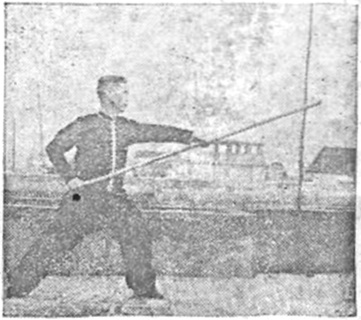
功用:
Application:
與十九式廿四式等相同。
Same as in Postures 19 & 24.
第二十七式:單手進棒
Posture 27: ADVANCE WITH A SINGLE-HANDED ATTACK
說明:
Explanation:
循上式,進右脚以成右登山式,棍自後放開左手直標而出,左掌置於頭上,如『定式』。
Continuing from the previous posture, your right foot advances to make a right mountain-climbing stance as your left hand lets go and the staff darts straight out, your left palm placed above your head. See photo 27:

功用:
Application:
對方之棍已為上式所封去,其中路由此而逞空虛,我亟集中所有力量而以單手衝擊之。
With the opponent’s staff having been sealed off with the previous technique, his middle area is now open, so I urgently concentrate all of my strength into my right hand and thrust out.
第二十八式:偷步倒揷
Posture 28: STEALTH STEP, POKING BEHIND
說明:
Explanation:
循上式左右兩脚仍未轉動,祇畧移過右方,左掌伸前重復握囘方去之棍,右手盡力收後,如「過渡式」
Continuing from the previous posture, your feet stay where they are and slightly pivot to the right as your right hand forcefully pulls the staff back and your left hand again grabs it. See photo 28a:

再進左脚,偷右脚以成右偷步之勢,棍自後斜向前,由上揷下,如『定式』。
Then your left foot advances and your right foot does a stealth step behind your left foot as the staff goes forward, held diagonally, and pokes downward from above. See photo 28b:

功用:
Application:
彼以我單手標棍為可欺,於是亟謀對我反擊,我不待其有所動作而先以左手接囘放出之棍,並採先動制敵之法,立卽跳前用棍端疾刺其足焉。
Momentarily scared away by my one-handed darting staff, the opponent then urgently seeks a way to counterattack. Before he has a chance to act, I pull back my staff to return my left hand to it, then immediately hop forward and send the tip swiftly poking to his foot. This is a technique of controlling the opponent by acting first.
第二十九式:崩打一棒
Posture 29: CUDGELING WITH AN AVALANCHE STRIKE
說明:
Explanation:
循上式,循古轉身以成右登山式,棍自上崩下,如『定式』。
Continuing from the previous posture, your body turns around to the right [and your right foot advances] to make a right mountain-climbing stance as you send the staff downward from above with an avalanche strike. See photo 29:

功用:
Application:
(與第二式相同。)
Same as in Posture 2.
第三十式:單提棍法
Posture 30: LIFTING THE STAFF WITH ONE HAND
說明功用:
Explanation & application:
(與第十式同)
Same as in Posture 10. See photo 30:

第三十一式:老僧穿衣
Posture 31: OLD MONK PUTS ON HIS ROBE…
說明:
Explanation:
(第十一式同。)
Same as in Posture 11. See photo 31:

功用:
Application:
其架於肩上如擔物狀者,純為誘惑性之作用,若妄進者每易受其轉身標棒之襲擊及走跳接單或雙接之挑擊,表面觀之乃屬呆滯,惟要研求之當可發現其妙處所在也。
The act of putting the staff on my shoulders like a yoke is simply meant to lure the opponent in. If he rashly advances, it would then be easy for me to turn my body and suddenly attack, for instance with the carrying technique in HOP FORWARD, DOUBLE UPWARD SWING. This posture appears on the surface to be foolish, but examine it more deeply and you will discover its ingenuity.
第三十二式:穿衣疾走
Posture 32: … AND SWIFTLY FLEES
說明:
Explanation:
循上式,原式不變,以竄跳方式疾走往西方,惟走時全身俱動乃容易引起棍之跳動,但能便棍不為牽動斯為合適矣。如「定式」。
Continuing from the previous posture, with your position not changing, you scurry away with a hop toward the west [left foot moving, then right], your whole body being drawn along by the movement of the staff pulling back rather than the staff following the movement of your body. See photo 32:

功用:
Application:
與上十一式相同。
Same as in Posture 11.
第三十三式:走跳雙接
Posture 33: HOP FORWARD, DOUBLE UPWARD SWING
說明:
Explanation:
循上式,先將右吞塌步轉過左方以成左登山之勢,棍由肩部向身傍斜斜殺落,如「過渡式」甲,
Continuing from the previous posture, first shift to the left to make a left mountain-climbing stance as the staff leaves your shoulders and swings down diagonally beside your body. See photo 33a:

再跳起將棍挑出,如「過渡式」乙,
Then hop forward as the staff goes out with a carrying action. See photo 33b:

當跳起時復將棍轉後方,比之第七式之單接是多轉一圈者,如『定式』。
Once you hop, let the staff arc again to the rear to then swing upward again. (This technique is similar to the single upward swing of Posture 7, but with an additional circle.) See photo 33c:

功用:
Application:
我用接連之蹤跳挑法,使對之者,實難予招迎也。
I use a method of continuously carrying while hopping to make it difficult for the opponent to engage.
第三十四式:收棍舉刀
Posture 34: WITHDRAW THE STAFF, RAISING THE SABER
說明:
Explanation:
「俱與第八式相同」循上式,原步不變,祇將棍由下復上,由右下方轉過左上方,再以左手重握棍之中段,登山式則由小轉大,目視右前方,如「定式」。
Continuing from the previous posture, with your stance not changing, the staff continues upward from below, going from the lower right to the upper left, and then your left hand again grabs the middle section as you continue forward into a right mountain-climbing stance. Your gaze is forward to the right. (The movement is the same as in Posture 8.) See photo 34:

功用:
Application:
單手挑棍者,僅求背城借一耳,若一擊落空,則我危險甚矣,於是每凡單接或之後,例必有收棍之勢以俟敵也,因其高舉而似大刀之勢,故以是得名。
Doing a carrying technique one-handed is a somewhat desperate act, meaning that if I miss, I would be in a perilous situation, and so after using the upward swinging technique, I have to withdraw my staff to prepare for whatever the opponent may do next. This posture feels similar to a position commonly adopted with the large saber, hence the name of the posture.
第三十五式:圈轉劈軋
Posture 35: COILING INTO A CRUSHING CHOP
說明:
Explanation:
循上式,原步不變,棍自上劈落至平,為「過渡式」用,
Continuing from the previous posture, with your stance not changing, the staff chops down from above to be parallel with the ground. See photo 35a:

再將棍直落轉向右後方,如「過渡式」乙,
The staff continues downward and arcing to the right rear. See photo 35b:

再進右脚以成跨馬式,棍自後向前跟馬殺落,合三式不停以至如『定式』圖。
Then your left foot advances to make a horse-riding stance as you send the staff smashing down forward from behind. (These three movements are to be performed as a continuous flow without any pauses between them.) See photo 35c:

功用:
Application:
來械自我中路突入,我卽用棍自舉刀式殺落彼再滿下攻我之下三路,我卽隨械轉落,使來械無突入機會,再進馬將棍轉過前方自上擊落,使彼上,中,下,三路,俱受我之威脅焉
The opponent suddenly attacks my middle area, so I send my staff smashing down from above, but he then takes advantage of the gap below and attacks my lower area, so I follow his movement by sending my staff arcing downward, giving his weapon no chance of getting near me, then advance while rolling my staff over and striking forward and downward from above, thereby threatening all three of his areas with attack (upper, middle, lower).
第三十六式:倒把反抽
Posture 36: SWITCHING THE ENDS OF THE STAFF, WHIPPING UPWARD
說明:
Explanation:
循上式,在未進馬之前,左手先探出至棍端,右手則出替左手之位置,使後方棍把漏出,然後進右脚以成騎馬式,棍隨步進,使棍貼身,自下逆抽而上,右手肘部向下沉,如『定式』。
Continuing from the previous posture, before advancing into another horse-riding stance, your left hand slides to the forward tip of the staff and your right hand slides to where your left hand just was, leaving the rear tip of the staff sticking out. Then your right foot advances to make a horse-riding stance as you send the rear tip of the staff forward, whipping upward from below, while bringing the other half of the staff against your body, your right elbow sinking down. See photo 36:
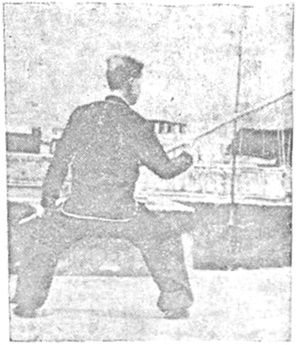
功用:
Application:
彼械為我上式所殺去,我卽跟馬進前倒把抽上,此式可連帶攻擊對方之下、中、上三路也。
Having smashed away the opponent’s weapon, I follow through by stepping forward and whipping upward with the rear tip of my staff. This technique can be a continuous attack to all three areas of the opponent – his lower level [first hitting against his leg], middle level [raking along his torso], and upper level [finally smacking against his chin].
第三十七式:跨虎倒圈
Posture 37: SITTING-TIGER STANCE, RETREATING WHILE COILING
說明:
Explanation:
循上式,先拉起右前脚,以成右跨虎步,棍畧上,左方抽起,如「過渡式」甲,
Continuing from the previous posture, first your right foot pulls back to make a right sitting-tiger stance as the staff slightly rises and withdraws to the left [initiating a counterclockwise circle]. See photo 37a:
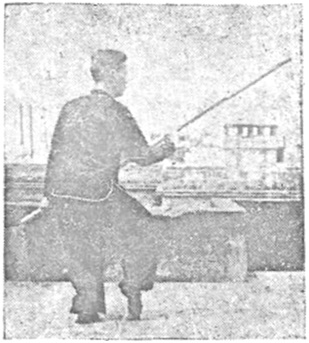
再偷右脚往左後方以成偷步之勢,棍把由上轉下,如「過渡式」乙,
Then your right foot retreats to the left rear, passing in front of your right foot as you send the forward tip of the staff downward from above. See photo 37b:

再退左脚以成右跨虎步,如過渡式甲,棍再由過渡式乙之倒把復轉而下,如『定式』。
Then your left foot retreats and again your right foot pulls back to make a right sitting-tiger stance as the staff arcs upward from below to finish in a position similar to photo 37a. See photo 37c:
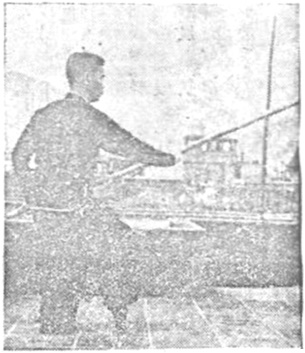
功用:
Application:
彼欲以械加於我上式,反抽之勢,我卽沿來械將圈漏去之,再自下逆抽其腕,斯乃避實就虛之法也。
Right as the opponent is about to counter my previous attack, I send my staff along with the movement of his incoming weapon, using an action of slipping & coiling [similar to Posture 25, except making a larger circle], and whip upward from below to strike to his wrist. This is a method of avoiding the strength of his force and attacking the weakness of his position.
第三十八式:崩打一棒
Posture 38: CUDGELING WITH AN AVALANCHE STRIKE
說明:
Explanation:
循上式,踏右脚進前以成右登門式,右手移開至棍端,然後放左手崩打而下,如『定式』。
Continuing from the previous posture, your right foot advances to make a right mountain-climbing stance as your right hand shifts to the forward end of the staff, your left hand lets go, and you send the staff downward with an avalanche strike. See photo 38:

功用:
Application:
與第二式同
Same as in Posture 2.
第三十九式:單提棍法
Posture 39: LIFTING THE STAFF WITH ONE HAND
說明功用:
Explanation & application:
與第十式同
Same as in Posture 10. See photo 39:

第四十式:老僧穿衣
Posture 40: OLD MONK PUTS ON HIS ROBE…
說明功用:
Explanation & application:
與十一式同
Same as in Posture 11. See photo 40:

第四十一式:穿衣疾走
Posture 41: … AND SWIFTLY FLEES
說明功用:
Explanation & application:
與十二式同
Same as in Posture 12. See photo 41:

第四十二式:走跳雙接
Posture 42: HOP FORWARD, DOUBLE UPWARD SWING
說明:
Explanation:
循上式,先將右吞塌步轉過左方以成左登山之勢,棍由肩部向身傍斜斜殺落,如「過渡式」甲,
Continuing from the previous posture, first shift to the left to make a left mountain-climbing stance as the staff leaves your shoulders and swings down diagonally beside your body. See photo 42a:

再跳起將棍挑出,如「過渡式」乙,
Then hop forward as the staff goes out with a carrying action. See photo 42b:

當跳起時復將棍轉後方,比之第七式之單接是多轉一圈者,如『定式』。
Once you hop, let the staff arc again to the rear to then swing upward again. (This technique is similar to the single upward swing of Posture 7, but with an additional circle.) See photo 42c:

功用:
Application:
我用接連之蹤跳挑法,使對之者,實難予招迎也。
I use a method of continuously carrying while hopping to make it difficult for the opponent to engage.
第四十三式:收棍舉刀
Posture 43: WITHDRAW THE STAFF, RAISING THE SABER
說明:
Explanation:
「俱與第八式相同」循上式,原步不變,祇將棍由下復上,由右下方轉過左上方,再以左手重握棍之中段,登山式則由小轉大,目視右前方,如「定式」圖。
Continuing from the previous posture, with your stance not changing, the staff continues upward from below, going from the lower right to the upper left, and then your left hand again grabs the middle section as you continue forward into a right mountain-climbing stance. Your gaze is forward to the right. (The movement is the same as in Posture 8.) See photo 43:

功用:
Application:
單手挑棍者,僅求背城借一耳,若一擊落空,則我危險甚矣,於是每凡單接之後,例必有收棍之勢以俟敵也,因其高舉而似大刀之勢,故以是得名。
Doing a carrying technique one-handed is a somewhat desperate act, meaning that if I miss, I would be in a perilous situation, and so after using the upward swinging technique, I have to withdraw my staff to prepare for whatever the opponent may do next. This posture feels similar to a position commonly adopted with the large saber, hence the name of the posture.
第四十四式:圈轉劈軋
Posture 44: COILING INTO A CRUSHING CHOP
說明功用:
Explanation & application:
(與第十五式同)
Same as in Posture 15. See photos 44a–44c:



第四十五式:倒把跨步
Posture 45: CROSSING STEP, SWITCHING THE ENDS OF THE STAFF
說明:
Explanation:
循上式,先原步不動,祗左手移開棍端處,右手則移前替囘左手之位置,如「過渡式」甲,
Continuing from the previous posture, with your feet staying where they are, your left hand slides to the forward tip of the staff and your right hand slides to the middle. See photo 45a:
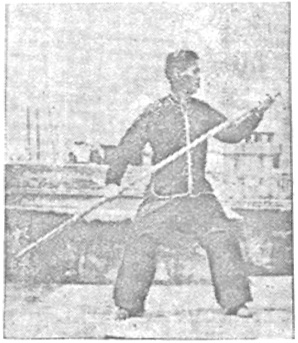
再先動左脚,繼起右脚向右斜方移動成一半圈形,卽成斜右登山式,斯卽跨步矣,棍隨身轉而以右下棍把反向上斜斜殺出,如『定式』。
Then your left foot shifts back and your right foot steps across to the left corner, drawing a semicircle with its movement and coming down to make a diagonal right mountain-climbing stance, your body turning to the left, as the rear tip of the staff rises up and smashes out diagonally. See photo 45b:
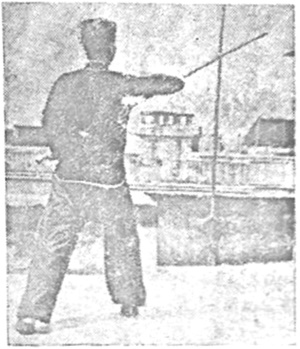
功用:
Application:
此是移步換形之法,使熟習者亦難得事先防備,我倒把而跨步益使對方難於捉摸矣,一切搏擊俱以靈巧活潑是尚,此棍法中不免之示範也。
This is a method of switching feet. Once you have become skillful at it, it is hard for an opponent to prepare against it. While I switch the ends of my staff, I also switch my feet in order to make it more difficult for the opponent to figure out what I am doing. When fighting, always value nimbleness and liveliness. This kind of technique is an exquisite example of the staff art.
第四十六式:跨步斜軋
Posture 46: CROSSING STEP, DIAGONAL CRUSHING
說明:
Explanation:
循上式,先原步不動,右手先向倒把移開,左手復向上移至棍鋒向下漏出,如「過渡式」甲,
Continuing from the previous posture, with your feet staying where they are, your right hand slides to the front tip of the staff and then your left hand slides to the middle, causing the rear tip to stick out forward and downward. See photo 46a:

再先動右前脚全身縱起向右方轉變,是為跨步,亦卽斜左登山式耳;棍隨身轉橫殺而出,如『定式』。
Then your whole body lunges across to the right, your right foot moving first, then your left foot, your feet performing a crossing step and finishing in a diagonal left mountain-climbing stance, as the staff smashes across. See photo 46b:

功用:
Application:
彼以械來迎我倒把之棍,我迅卽移步換勢反用棍鋒橫殺彼上中兩路,其法至迅速而强勁,勿以等閒視之也。
The opponent uses his weapon to deflect my previous attack, so I quickly switch my feet and send my staff smashing across to his upper area or middle area. This technique is fast and powerful, and so do not dismiss it as unimportant.
第四十七式:偷步明封
Posture 47: STEALTH STEP, CLEANLY SEALING
說明:
Explanation:
循上式,右脚自後偷往前方,棍由下斜抬起往上,使攔住身體之各部,如「過渡式」
Continuing from the previous posture, your right foot advances with a stealth step, going behind your left foot, as the staff lifts diagonally upward from below, thereby blocking off all three sections of your body. See photo 47a:

再開左脚進前以成左登山步,棍向正方盡力軋出,如『定式』
Then your left foot advances to make a left mountain-climbing stance as the staff goes forward with a crushing action. See photo 47b:

功用:
Application:
彼欲俟機反攻,我乃先偷步以備易於進前,再以棍攔拒之,彼眞欲來時,我則明封之,斯卽暗入明出之法也。
While the opponent waits for the right moment to counterattack, I do a stealth step in readiness to advance upon him easily while using the staff to block anything that comes. Once he decides to attack, I am thus able to cleanly seal it off. This is a method of “entering shade and then emerging into sunlight”.
第四十八式:扑腿低撇
Posture 48: REACHING-LEG STANCE, SWINGING BELOW
說明:
Explanation:
循上式,先將右後脚拍貼於左前脚,再成向東正線,左前鋒往後手收貼於右手,如「過渡式」甲,
Continuing from the previous posture, first your right foot stomps down next to your left foot, the toes of both feet pointing toward the south, as your left hand goes forward next to your right hand. See photo 48a:

再將左脚向前東方開出,以成左扑腿式,右手向前開,右手往後拉,使棍端橫撇於左下方,右手高提如「定式」。
Then your left foot steps out forward toward the east to make a left reaching-leg stance as your right hand holds its end of the staff forward, lifting high, and your left hand pulls to the rear, causing the staff tip to swing across to the lower left. See photo 48b:

功用:
Application:
彼再走我左方,用械取我下路,我乃先以扑腿法低勢迎之,再以棍低撇,使來械被撇而有機會反擊其他處也。
The opponent now moves over to my left side and tries to attack my lower area, so I engage him by getting into a reaching-leg stance and using my staff to swing across below, thereby deflecting his weapon and giving me an opportunity to counterattack.
第四十九式:纏攔囘身
Posture 49: COILING BLOCK WHILE RETREATING
說明:
Explanation:
循左式,原步不變,棍由後斜方拉過前上方,如「過渡式」甲,
Continuing from the previous posture, with your stance not changing [apart from rising up], pull the staff diagonally forward and upward from behind. See photo 49a:

再以左脚由前偷過後方,棍由前上撥過左後斜方,如「過渡式」乙,
Then your left foot does a stealth step, passing in front of your right foot, as you send the staff deflecting diagonally to the left rear. See photo 49b:

再退右脚以成左吞塌步,棍再由後自下反向上正方抽起,以成如『定式』。
Then your right foot retreats to make a gulp & sink stance as you return the staff upward from below, pulling it back. See photo 49c:

功用:
Application:
此式之返身乃用連蹤帶跳方式而走,棍用上下挑攔之法,極盡遮攔架格之能事,彼雖集多人用械追來,吾亦無所畏也。
This technique involves retreating with continuous hops while the staff goes up and down with actions of blocking [to the left] and carrying [to the right]. Such skillful blocking enables me to fend off multiple weapon-wielding attackers without panicking.
第五十式:纏攔囘身
Posture 50: COILING BLOCK WHILE RETREATING
說明功用:
Explanation & application:
與四十九式同。
Same as in Posture 49. See photos 50a–50c:



第五十一式:纏攔囘身
Posture 51: COILING BLOCK WHILE RETREATING
說明功用:
Explanation & application:
與四十九式同。
Same as in Posture 49. See photos 51a–51c:



第五十二式:中平軋槍
Posture 52: STANDING STABLY, CRUSHING A SPEAR
說明:
Explanation:
循上式,化左吞塌步為左登山式,棍自後直軋而出,其定式與十九式同,如『定式』。
Continuing from the previous posture, switch into a left mountain-climbing stance as you send the staff straight out with a crushing action. (The movement is the same as in Posture 19.) See photo 52:

功用:
Application:
(與第十九式同)
Same as in Posture 19.
第五十三式:跨虎倒把
Posture 53: SITTING-TIGER STANCE, SWITCHING THE ENDS OF THE STAFF
說明:
Explanation:
循上式,右脚自後進前以成右跨虎步,以棍自後向前,由上壓下,使左右手易後作前,如『定式』。
Continuing from the previous posture, your right foot advances to make a right sitting-tiger stance as your left hand slides to the forward tip of the staff, your right hand slides to the middle, and you send the rear tip of the staff forward, pressing down from above. See photo 53:

功用:
Application:
彼械為我上式之明封法所封去,我隨而進馬運用倒把自上力壓之,凡用槍棍者類皆以能用此者方為上乘之技,否則便有所弊矣。
Having sealed off the opponent’s weapon, I follow through by advancing while switching the ends of my staff and forcefully pressing down from above. In both the spear art and staff art, the ability to make use of the other end of the weapon represents a high level of skill, whereas the lack of such an ability is a major drawback.
第五十四式:夾肘統捶
Posture 54: PINCHING THE STAFF WITH YOUR ELBOW, THRUST PUNCH
說明:
Explanation:
循上式,原步不動,右手先將棍把轉入右肘之下如「過渡式」甲,
Continuing from the previous posture, with your feet staying where they are, your left hand rolls its section of the staff forward and your right hand rolls its section of the staff under your left elbow. See photo 54a:
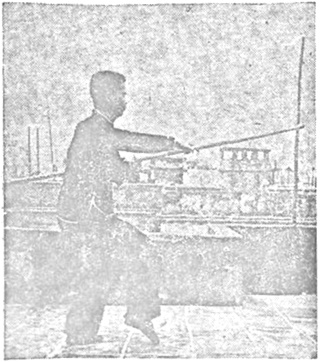
再放下前脚,右手自右肘下轉出,左手轉過右肩之下,如「過渡式」乙,
Then your right foot comes down forward as your right hand rolls its section of the staff forward from below your left elbow and your left hand rolls its section of the staff below your right shoulder. See photo 54b:
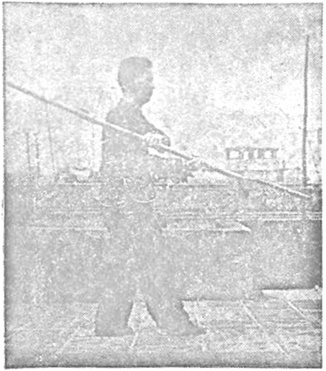
再將右手之下棍端向後轉收於腰部,左手反轉於前方,如「過渡式」丙,
Then your right hand rolls its section to the rear, pulling it back to your waist, as your left hand rolls its section forward. See photo 54c:
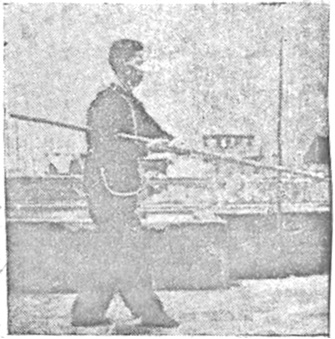
再左脚進前以成左跨虎步,右手夾定全棍,棍端下垂,左拳自腰直冲而出,如『定式』
Then your left foot advances to make a left sitting-tiger stance as your right arm pinches the staff against you, the tip hanging down, and your left fist thrusts out from your waist. See photo 54d:
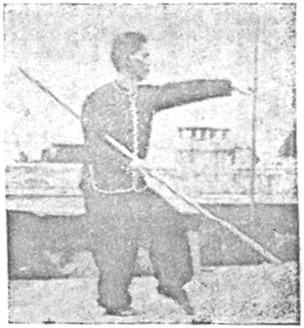
功用:
Application:
此棍法乃僅打半個花而已!棍槍之花其作用雖微,然半個花則反見有嚴密性之作用存在,對防守性尤勝於全花者多矣。
This technique is merely a half flourish. Although there is little actual function to the flourishing movements of the staff and spear, there is a useful compactness to a half flourish that tends to make it a better defensive action than a full flourish.
第五十五式:走步斜挑
Posture 55: WALKING FORWARD, HOPPING DIAGONALLY
說明:
Explanation:
循上式,放下左脚進前右脚,再將左拳重復握於棍之上中段,如「過渡式」甲,
Continuing from the previous posture, your left foot comes down and your right foot advances as your left hand again grabs the middle section of the staff. See photo 55a:
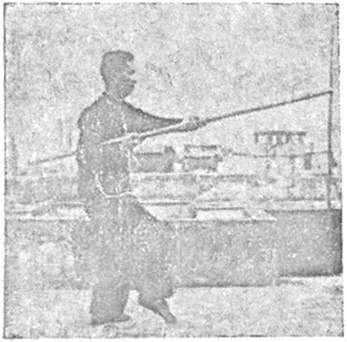
再將右手移於棍之末端,繞半圈以離開腋下轉過左方,如「過渡式」乙,
Then your right hand shifts to the rear tip of the staff as the staff arcs a half circle to the left, bringing it away from your right armpit. See photo 55b:
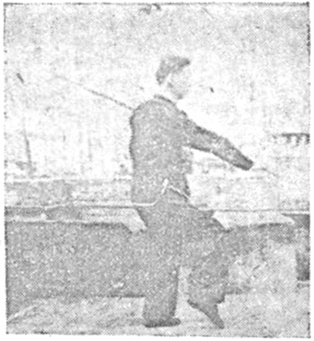
循此蹤身向斜方跳往以成右登山式,棍則旋轉一匝,卽由上而下,復由下反上,再轉於下是也,如『定式』。
Then you hop diagonally into a right mountain-climbing stance as the staff draws a circle downward, upward, and downward again. See photo 55c:
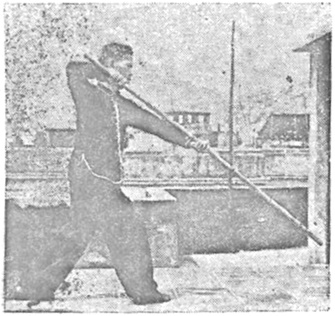
功用:
Application:
彼以械或上或下,或分上下同時攻來,我乃有顧此失彼之虞!於是乃用上下並顧之法應之,使其無法近我也。
The opponent attacks above or below, or both one after the other, giving me too much to deal with all at once, so I use a movement that covers both areas, causing him to have no way to get near me.
第五十六式:隨風招展
Posture 56: BANNER FLUTTERING IN THE BREEZE
說明:
Explanation:
循上式,原步不變,先將棍向頭上高舉,再向後轉,如「過渡式」甲,
Continuing from the previous posture, with your stance not changing, first lift the staff high over your head, your torso turning to the left. See photo 56a:
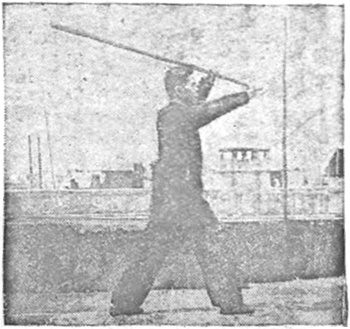
再往後疾走一步棍反轉往前方,如「過渡式」乙,
Then your left foot quickly retreats a step as you send the staff turning over forward [with your right hand pulling it back and your left hand pressing it forward]. See photo 56b:

再由右登門轉為左登山步,棍鋒則向下沉轉半個圈而復歸於上,向後注視,如『定式』。
Then you switch from a right mountain-climbing stance to a left mountain-climbing stance as you send the tip of the staff sinking down and arcing through a half circle which brings it upward again, your gaze following it to the rear. See photo 56c:

功用:
Application:
棍是由頭頂而上轉,卽所謂(雪花蓋頂)者是也,用走跳蹤距方式者最適合不過矣。
I send the staff arcing above from over my head, a technique called SNOW COVERS THE MOUNTAIN PEAK, while hopping away to create distance from the opponent, though not going so far away that I cannot then attack him.
第五十七式:黑虎下山
Posture 57: BLACK TIGER BOUNDS DOWN THE MOUNTAIN
說明:
Explanation:
循上式,將左登山轉為右登山式,棍自後平直殺出如『定式』。
Continuing from the previous posture, switch from a left mountain-climbing stance to a right mountain-climbing stance as the staff arcs from the rear and goes out forward and downward with a smashing action until parallel with the ground. See photo 57:

功用:
Application:
彼以我右方空虛,卽自我右擊入,我迅卽轉馬以棍平殺而下,旣使彼械無法迫近,復可以居高臨下之優勢而决定其勝負矣。
The opponent takes advantage of the gap on my right side and attacks me there, so I quickly switch my stance and send my staff smashing down, causing his weapon to have no way to get close to me, and then since I now have the superior position of the high ground, I am better placed to determine which one of us will be the victor.
第五十八式:圈轉劈軋
Posture 58: COILING INTO A CRUSHING CHOP
說明:
Explanation:
名稱及定式雖與第十五式同,但十五式是上步而成,此式則全身跳起,在凌空中轉為馬式着地者,祈注意焉『如定式』。
The posture name and final position are the same as in Posture 15, except that Posture 15 involves stepping forward into the horse-riding stance, whereas this posture involves jumping up and switching feet to get into the horse-riding stance. I hope you will pay attention to this difference. See photos 58a & 58b:


功用:
Application:
十五式者慢而穩健此式則迅速而沉雄實各有千秋也,隨機應變方為武術之握要也。
Posture 15 is performed slower and more steady, whereas this posture is performed more quickly and sinks down more powerfully. Both versions of the technique have their merits. Once you are acting according to circumstances, you have then grasped the most important aspect of martial skill.
第五十九式:走跳倒接
Posture 59: HOP BACK, UPWARD SWING
說明:
Explanation:
循上式,(凡單接或雙接俱向前為之者)但此式則反向後行之,當我馬式圈,劈中原步不變棍自下反挑歸後方,棍動卽疾走過右後方一步,如「過渡式」甲,
Continuing from the previous posture, hop back to land again in a horse-riding stance as the staff carries upward from below and continues to the right rear. (The other occasions of carrying, both single carrying and double carrying, involve hopping forward, whereas this time it is a hop backward.) See photo 59a:

再將棍轉往頭上,左手由下托上再握棍之上端,如『定式』。
Then send the staff arcing over your head, your left hand propping upward from below to again grab the upper section the staff. See photo 59b:
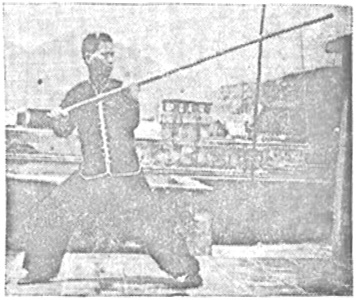
功用:
Application:
我旣常出擊之單雙接法,當易為對方所洞悉,於是乃改戰畧之一法也。
If I too frequently attack with carrying techniques, whether single carrying or double carrying, it will be easy for the opponent to anticipate me, therefore I now slightly alter the way I perform this technique to keep him guessing.
第六十式:走跳單接
Posture 60: HOP FORWARD, SINGLE UPWARD SWING
說明功用:
Explanation & application:
(與第七式同)
Same as in Posture 7. See photos 60a & 60b:


第六十一式:收棍舉刀
Posture 61: WITHDRAW THE STAFF, RAISING THE SABER
說明功用:
Explanation & application:
(與第八式同)
Same as in Posture 8. See photo 61:
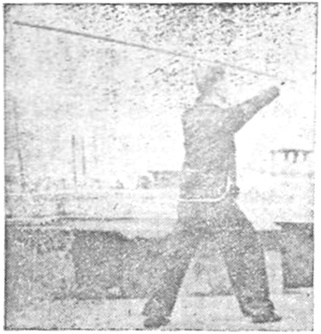
第六十二式:崩打一棒
Posture 62: CUDGELING WITH AN AVALANCHE STRIKE
說明:
Explanation:
循上式,先將右脚向東開出一步,以成右登山式,棍僅藉右手握持而向地打下,而左手離棍後則化掌架於頭上,當棍到地時,必有甚响喨之聲音,而棍亦被反彈力所跳起矣,切勿使棍再有觸地病,否則便有毫厘之差矣,如第六十二圖。
Continuing from the previous posture, your right foot steps out to the east to make a right mountain-climbing stance as your right hand sends the staff striking downward to the ground, your left hand letting go and propping above your head as a palm. (When the staff hits the ground, it has to provide a resounding crack. The bounce from the impact should also lift it right back up. Allow it to rise when it does and do not let it fall back down to hit the ground again.) See photo 62:

功用:
Application:
當我上式高舉棍時,已是準備由上擊落彼方矣,如彼自我中下路擊來,我卽利用居高臨下之優勢而用崩打一棒之法,疾殺來械也。
With the staff raised high in the previous posture, I am already prepared to send it striking downward, so if an opponent attacks my middle area or lower area, I take advantage of my position of “having the high ground” by using this avalanche technique to smash down his weapon.
第六十三式:單提棍法
Posture 63: LIFTING THE STAFF WITH ONE HAND
說明:
Explanation:
循上式,左右脚不變原來位置,僅由右登山轉為左登山式,將崩下之棍曲右肘往上向左提起,左手握拳置於右肩部,棍平中而端鋒畧高,如「定式」。
Continuing from the previous posture, with your feet staying where they are, your stance simply switching from a right mountain-climbing stance to a left mountain-climbing stance, your right hand lifts the staff up to the left side, the elbow bending, as your left hand forms a fist and is placed at your right shoulder, the staff almost parallel with the ground, the tip slightly higher. See photo 63:

功用:
Application:
此提棍式與下式之老僧穿衣,俱為棍中之少見者,亦卽寓有特殊之妙用焉,單手指棍者,取其快速耳!而左手旣近棍而偏不握者,是視對方用力多少而定也,且在接棍之頃刹,尤能直手標向敵方,標然轉身變式者亦知便利也。
This posture and the following posture are both rarely seen within staff sets, and yet they are rather wonderful, pointing the staff with just one hand and striving to move with quickness. My left hand gets near the staff, but does not grab it. I am now observing the strength of the opponent, for in the moment when I have lifted the staff, I am perfectly placed to be able to suddenly dart it straight out toward him and then turn my body and move away from him.
第六十四式:老僧穿衣
Posture 64: OLD MONK PUTS ON HIS ROBE…
說明:
Explanation:
循上式,提起左脚用力再踏下,當踏步之時,右後脚從面前轉過西方為右登山式,同時棍已加諸肩上矣,左拳更乘勢伴過東方,同時往後注視如「定式」。
Continuing from the previous posture, your left foot lifts and stomps down, then your right foot steps toward the west, passing in front of you [as your body turns around leftward], to make a right mountain-climbing stance, the staff being placed on top of your shoulders [as your right hand pulls it toward the west], your left fist correspondingly extending toward the east. See photo 64:

功用:
Application:
其架於肩上如担物狀者,純為誘惑性之作用,若妄進者每易受其轉身標棒之襲擊與及走跳單接或雙接之挑擊,表面觀之乃屬呆滯,惟要研求之當可發現其妙處所在也。
The act of putting the staff on my shoulders like a yoke is simply meant to lure the opponent in. If he rashly advances, it would then be easy for me to turn my body and suddenly attack, for instance with the carrying technique in HOP FORWARD, DOUBLE UPWARD SWING. This posture appears on the surface to be foolish, but examine it more deeply and you will discover its ingenuity.
第六十五式:穿衣疾走
Posture 65: … AND SWIFTLY FLEES
說明功用:
Explanation & application:
與第六十四式
Same as in Posture 64. See photo 65:

第六十六式:黑虎下山
Posture 66: BLACK TIGER BOUNDS DOWN THE MOUNTAIN
說明:
Explanation:
循上式,左拳化為封手自面前重握棍之中段,上右脚成右登山步,棍者上殺下,其定式與五十七式同,如『定式』。
Continuing from the previous posture, your left fist becomes a sealing hand, going out from in front of you and grabbing the middle section of the staff [your right hand then letting go of the rear tip and grabbing the forward tip] and then your right foot steps forward to make a right mountain-climbing stance as the rear tip of the staff rises up and smashes down forward from above. (The final position is the same as in Posture 57.) See photo 66:

功用:
Application:
(與五十七式同)。
Same as in Posture 57.
第六十七式:圈轉劈軋
Posture 67: COILING INTO A CRUSHING CHOP
說明:
Explanation:
定式及名稱與十五式同。
Same as in Posture 15. See photos 67a & 67b:


功用:
Application:
變式則與五十八式同。
Same as in Posture 58.
第六十八式:馬式倒把
Posture 68: HORSE-RIDING STANCE, SWITCHING THE ENDS OF THE STAFF
說明:
Explanation:
循上式,進右脚以成騎面式,棍用倒把向前曲上劈落,如『定式』。
Continuing from the previous posture, your left hand slides to the forward tip of the staff, your right hand slides to the middle, then your right foot advances to make a horse-riding stance as you send the rear tip of the staff forward, chopping down from above. See photo 68:

功用:
Application:
彼避過我圈劈之勢卽走過我左後方欲予襲擊,我不俟其攻來卽改用倒把進馬殺之。
The opponent evades my coiling chop and moves to try to attack me from the left, so I respond before his attack emerges by switching the ends of my staff and then advancing into a horse-riding stance as I attack him with a smashing action.
第六十九式:換棒軋槍
Posture 69: ROLLING CUDGEL, CRUSHING A SPEAR
說明:
Explanation:
循上式,先原步不動,祇將棍把畧垂低,如「過渡式」甲,
Continuing from the previous posture, with your feet staying where they are, your left hand lets go [and your right hand rolls the staff over forward, turning the rear tip into the front tip, your right hand switching from the center of the hand facing downward to facing upward]. See photo 69a:

由馬式轉為右登山式,左後手放棍,如「過渡式」乙,
Then switch to a right mountain-climbing stance as your left hand again grabs the staff [with the center of the hand switched from facing upward to facing downward] and pulls the rear tip upward and inward [causing the front tip to deflect downward to the left]. See photo 69b:
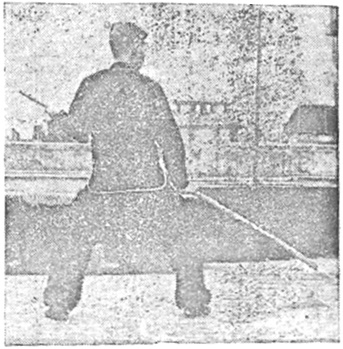
再以左脚自後偷前,左後手反握回棍之下端,如「過渡式」丙,
Then your left foot advances with a stealth step, going behind your right foot, as your left hand pulls the rear tip of the staff downward and inward [causing the front tip to deflect upward to the left]. See photo 69c:
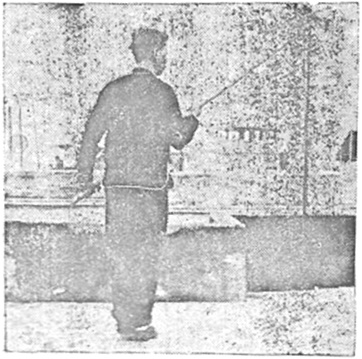
再開出右脚以成右登山式,棍自後力軋而出,如『定式』。
Then your right foot advances to make a right mountain-climbing stance as you forcefully send the staff forward with a crushing action. See photo 69d:
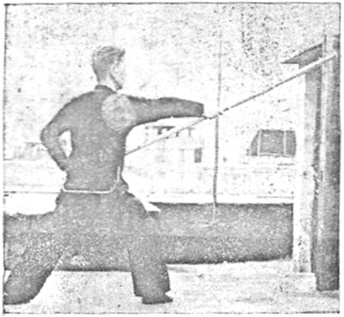
功用:
Application:
先撥去下路來械,再撥去上路來械,更以偷步法轉後作前以明封來槍。
I first deflect the opponent’s spear as he attacks my lower area, then again deflect his spear as he attacks my upper area, and then I do a stealth step and seal off his spear.
第七十式:馬式倒把
Posture 70: HORSE-RIDING STANCE, SWITCHING THE ENDS OF THE STAFF
說明:
Explanation:
循上式,右手採前至棍端而止,左手繼出以代右手原有之位置,再進左後脚以成騎馬式,棍用左倒把由後向前,自上劈落,如「定式」。
Continuing from the previous posture, your right hand slides to the forward tip of the staff, your left hand slides to the middle, then your left foot advances to make a horse-riding stance as you send the rear tip of the staff forward, chopping down from above. See photo 70:

功用:
Application:
彼以我械正向上路,乃沉械以擊我下路,於是我乃改用倒把進馬劈之。
The opponent takes advantage of the moment that my weapon is above by lowering his weapon and attacking me below, so I switch the ends of my staff and then advance into a horse-riding stance as I attack him with a chopping action.
第七十一式:挨棒軋槍
Posture 71: ROLLING CUDGEL, CRUSHING A SPEAR
說明:
Explanation:
循上式,原步不動,右後手放棍,並將棍末端反向前使左手得反陰手為陽手,如「過渡式」甲,
Continuing from the previous posture, with your feet staying where they are, your right hand lets go and your left hand rolls the staff over forward, turning the rear tip into the front tip, your left hand switching from the center of the hand facing downward to facing upward. See photo 71a:

再由馬式轉為左登山式,棍端由外朝起反向內如「過渡式」乙,
Then switch to a left mountain-climbing stance as your right hand again grabs the staff [with the center of the hand switched from facing upward to facing downward] and pulls the rear tip upward and inward [causing the front tip to deflect downward to the right]. See photo 71b:

再將右脚由後偷前,右手復握棍之末端,如「過渡式」丙,
Then your right foot advances with a stealth step, going behind your left foot, as your right hand pulls the rear tip of the staff downward and inward [causing the front tip to deflect upward to the right]. See photo 71c:

再進左脚以成左登山式,棍自後盡力軋前,(與69式同,如69式看不清者,可於此參証之。)
Then your left foot advances to make a left mountain-climbing stance as you forcefully send the staff forward with a crushing action. (These movements are the same as in Posture 69, though on the other side, so if those movements were not clear, perhaps these will help clarify.) See photo 71d:

功用:
Application:
與六十九式同,祇左右之同耳。
Same as in Posture 69, except with left and right reversed.
第七十二式:扑腿低撇
Posture 72: REACHING-LEG STANCE, SWINGING BELOW
說明:
Explanation:
循上式,先將右後脚拍貼於左前脚,再成向東正綫,左前鋒往後手收貼於右手,如「過渡式」甲,
Continuing from the previous posture, first your right foot stomps down next to your left foot, the toes of both feet pointing toward the south, as your left hand goes forward next to your right hand. See photo 72a:

再將左脚向前東方開出,以成左扑腿式,右手向前開,右手往後拉,使棍端橫撇於左下方,右手高提如「定式」。
Then your left foot steps out forward toward the east to make a left reaching-leg stance as your right hand holds its end of the staff forward, lifting high, and your left hand pulls to the rear, causing the staff tip to swing across to the lower left. See photo 72b:

功用:
Application:
彼再走我左方,用械取我下路,我乃先以扑腿法低勢迎之,再以棍低撇,使來械被撇而有機會反擊其他處也。
The opponent now moves over to my left side and tries to attack my lower area, so I engage him by getting into a reaching-leg stance and using my staff to swing across below, thereby deflecting his weapon and giving me an opportunity to counterattack.
第七十三式:纏攔囘身
Posture 73: COILING BLOCK WHILE RETREATING
說明:
Explanation:
循左式,原步不變,棍由後斜方拉過前上方,如「過渡式」甲,
Continuing from the previous posture, with your stance not changing [apart from rising up], pull the staff diagonally forward and upward from behind. See photo 73a:

再以左脚由前偷過後方,棍由前上撥過左後斜方,如「過渡式」乙,
Then your left foot does a stealth step, passing in front of your right foot, as you send the staff deflecting diagonally to the left rear. See photo 73b:

再退右脚以成左吞塌步棍再由後自下反向上正方抽起,以成如『定式』。
Then your right foot retreats to make a gulp & sink stance as you return the staff upward from below, pulling it back. See photo 73c:

功用:
Application:
此式之返身乃用連縱帶跳方式而走,棍用上下挑攔之法,極盡遮攔架格之能事,彼雖集多人用械追來,吾亦無所畏也。
This technique involves retreating with continuous hops while the staff goes up and down with actions of blocking [to the left] and carrying [to the right]. Such skillful blocking enables me to fend off multiple weapon-wielding attackers without panicking.
第七十四式:纏攔囘身
Posture 74: COILING BLOCK WHILE RETREATING
說明功用:
Explanation & application:
與二十一式同。
Same as in Posture 21. See photos 74a–74c:



第七十五式:纏攔囘身
Posture 75: COILING BLOCK WHILE RETREATING
說明功用:
Explanation & application:
與二十一式同。
Same as in Posture 21. See photos 75a–75c:



第七十六式:中平軋槍
Posture 76: STANDING STABLY, CRUSHING A SPEAR
說明功用:
Explanation & application:
與二十四式同。
Same as in Posture 24. See photo 76:

第七十七式:旋轉纏攔
Posture 77: TURN AROUND, COILING BLOCK
說明:
Explanation:
循上式,由前循右轉身,提起右脚以成右胯虎步,棍由前倒把歸後壓下,如「過渡式」甲,
Continuing from the previous posture, your body turns around to the right, your right foot pulling in to make a right sitting-tiger stance, as your left hand slides to the forward tip of the staff, your right hand slides to the middle, and you use the rear tip of the staff to press down to the rear. See photo 77a:
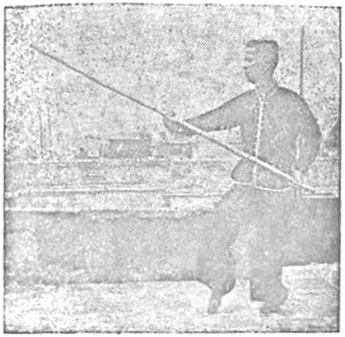
再開右脚進前,以倒把夾於左肘下,左手持棍向前壓下,如「過渡式」乙,
Then your right foot advances as your right hand slides to what is now the front section of the staff, your left hand slides to the middle, and you roll the staff over to send the rear tip forward and pressing downward, your right hand bringing the forward section under your left armpit. See photo 77b:
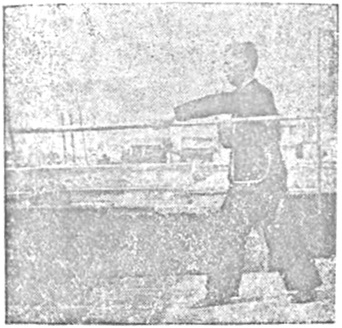
再進右脚,棍循左轉歸右方而入於右肘之內,如「過渡式」丙,
Then your left foot advances, your body continuing to turn to the right, as your left hand brings its section of the staff to the right and your right hand sends its section forward from under your left elbow. See photo 77c:
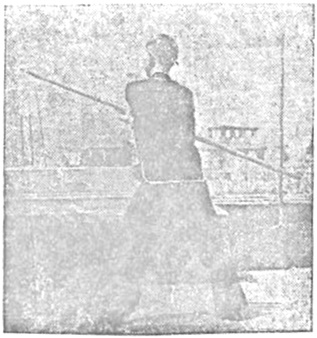
再將右後脚偷過左方,棍亦隨而轉去,使左方為下,右為上,如「定式」。
Then your right foot does a stealth step, passing behind your left foot as your left hand rolls its section of the staff downward to the left and your right hand sends its section upward to the right. See photo 77d:
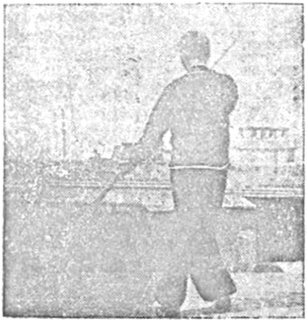
功用:
Application:
合四個圖片僅為打一個如槍之轉身花而已。
These four movements are little more than a spear-like flourish while turning the body.
第七十八式:登山棒獻
Posture 78: MOUNTAIN-CLIMBING STANCE, PRESENTING THE CUDGEL
說明:
Explanation:
循上式,左右兩脚不變原來方向,祇循左轉身便可成為左登山式矣,棍亦由後隨步轉前舉起如「定式」。
Continuing from the previous posture, your feet stay in their location and simply pivot along with the leftward turn of your body to make a left mountain-climbing stance as the staff arcs forward from the rear and lifts up. See photo 78:

功用:
Application:
彼欲自我後襲擊,我卽隨步轉身以舉棒法消解其上中下三路之攻擊。
An opponent tries to attack me from behind, so I turn around and use a raising-cudgel technique to dispel his attack at any of the three levels.
第七十九式:跨虎提棒
Posture 79: SITTING-TIGER STANCE, LIFTED CUDGEL
說明:
Explanation:
循上式,先原脚不動,再以右下左上向地揷下,如「過渡式」甲,
Continuing from the previous posture, with your feet staying where they are, your right hand lowers, your left hand staying up, and you poke the staff down to the ground. See photo 79a:

再將左脚拉起以成左跨虎步,放開右手化掌轉過後方灣而向上,左手亦同時向前伸直,如「定式」。
Then your left foot pulls back to make a left sitting-tiger stance as your right hand lets go, becoming a palm, and arcs to rear and above, your left arm extending forward. See photo 79b:
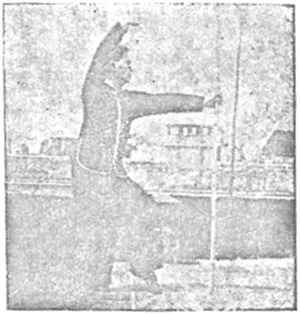
功用:
Function:
此為全棍之收式
This is the concluding posture for the entire set.
第八十式:挾棒中平
Posture 80: EMBRACE THE CUDGEL, STANDING STABLY
說明:
Explanation:
循上式,左前脚向右脚拍齊,右手垂下,棍抱於身傍,斯為完式後之立正式也。
Continuing from the previous posture, your left foot stomps down next to your right foot as your right arm hangs down and your left hand brings the staff in at the side of your body. This is an action of standing at attention after the concluding posture [with your body facing the opposite direction of the beginning posture]. See photo 80:
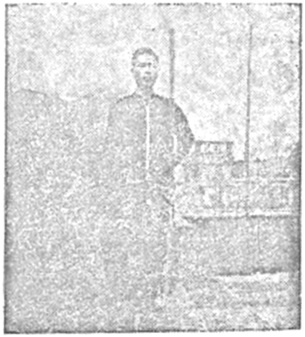
– – –
[As a bonus, included below is a chapter from Huang’s Notes on the Mantis Boxing Art (1951).]
拳怕少壯?刀怕莽撞?棍怕老狠?
ON THE TRUE MEANING OF THESE SAYINGS: “FISTS FEAR THE YOUNG AND VIGOROUS.” “SABERS FEAR THE RASH AND IMPETUOUS.” “STAFFS FEAR THE OLD AND RUTHLESS.”
未學功夫先學跌打,未出拳頭先學搭馬,此二語同此篇,三怕之題目,幾為習武者之口頭諺語,然言之者衆,知之者寡,余自幼則凡事好作反面推測,對斯俗諺亦曾作一推斷,但以世俗所限未敢公開論之,年前旅行羊石,順道探訪舅父余巨川氏,余舅早年嘗從百粵名師如王隱林等遊、技術湛深,且置父業弗顧,隻身往來叢林禪院之間,以訪高明,生平好作諧語,每事多有超乎常人之理論,余以胸中蘊積提出共論之,余舅聞余言但微笑不答,至言畢即鼓掌曰,不料世亦有同調之人,可謂吾道不孤矣,余舅云,早廿年曾以與余相同之意見質諸當時之俊彦,皆斥為妄談,是故心雖難平,亦不敢更作此論斷,不意廿年後與余暗合此反常之論,因而愉快頗甚,余舅與余此一會後,未經年即謝世,享高年而兒孫繞膝,可謂人生之極樂矣,祗可惜表兄弟皆從商作賈,未能克紹箕裘耳。茲舉余舅與余共同之見如下述。
“Before learning how to fight, learn how to fall. Before learning how to punch, learn how to stand.” These two sayings have a similar theme to the “three fears”. Commonly used by martial arts practitioners, the three fears have been recited by many, but are understood by few. As I have always loved to examine things from different angles, I once came up with a theory about the true meaning of these sayings, but I have since refrained from discussing it, not wishing to create controversy by contradicting the common understanding.
Then last year, while traveling to Yangcheng [alternate name for Guangzhou], I visited my uncle Yu Juchuan on the way. As a young man, he had learned from many famous teachers in Guangdong, such as Wang Yinlin, whose skill was profound. Abandoning his family’s business, he went off on his own to a temple in the forest in order to seek out wisdom. Throughout his life, he loved to see the funny side of everything and thus he had insights about things beyond the imagination of ordinary people.
I decided to share my interpretation of these sayings with him. He listened to me with a silent smile, and then when I had finished, he clapped his hands and said: “I can’t believe there’s someone who thinks like me. I’m not alone after all!” He then went on: “Twenty years ago, I shared the same ideas with many worthy gentlemen, all of whom dismissed my interpretation as absurd, and so although I disagreed with them in my mind, I dared not discuss it openly anymore. Now after twenty years, I finally meet someone who agrees with my abnormal theories, and I must say I’m delighted.”
Not long after this time with him, my uncle passed away. In his last years, he got to enjoy the experience of grandchildren running around his knees, and in that regard it could be said that he achieved the greatest happiness. However, it is a pity that his sons all went into business instead of following in their father’s footsteps and carrying on his skills. As for the interpretation that my uncle and I both realized, it is provided below:
拳怕少壯?
“Fists fear the young and vigorous.”
年少之人火候正盛,動輒盲衝直撞,而且閱歷未深,其不値得人怕者,至為明顯,一般人多誤會年少力壯之拳術家,為人所畏懼,然諸君閉目思之,一個少年拳術家為可畏乎?抑或一個經驗豐富,出入於拳脚陣中之老師傳為可畏?則吾之拳怕少壯,實為怕本身年紀太少,火候壯盛,致為經驗老到者所算,非人所怕,實本身自怕其理至淺也。
Although young people are in the prime of their vitality, their actions are more a matter of blindly crashing against opponents instead of moving with finesse. Lacking depth of experience, their attacks are obvious rather than sneaky, and thus they are not worth fearing. Ordinary people often think we fear fighters who are young and strong, but if you stop and think about it, what is there to fear from a younger fighter? Does it not make more sense to fear the punches and kicks of older masters who have much more experience? Therefore when we speak of fearing youthful vigor, we are actually talking about our own immaturity. Despite being at the peak of vitality, we are nothing when encountering the calculating precision of seasoned masters. It is not other people we should fear, but rather that our own level of understanding is too superficial.
刀怕莽撞?
“Sabers fear the rash and impetuous.”
雖有搏命單刀之說,但非盲衝直撞之謂,單刀是短器械之一,練時用時皆須貼身繞背,使前後、左右、上下均得呼應,是為用刀之正範,若夫一刀在手便衝扑追殺,此匹夫耳,何得謂為刀法正宗,刀怕莽撞之說,非敵所懼,實用之者所怕,前賢戒語,後人反道行之,以此相沿,成例能不為武界痛惜哉。
There is a further saying: “When it’s a fight to the death, use a saber.” For both of these sayings, the meaning has nothing to do with blindly rushing in. Because the saber is one of the short weapons, practicing with it or actually using it in combat involves bringing it near your body and around your back, and so there has to be good coordination between forward and back, left and right, above and below in order to be performing with it correctly. To simply charge forward with it, like an ordinary person would, is not authentic. Therefore the meaning is not really about making the opponent afraid, but about the saber wielder being aware. Earlier masters intended it as a warning, whereas later generations perverted the meaning into mere bravado. Unfortunately for the martial arts community, the saying has been passed down with the wrong idea ever since.
棍怕老狠?
“Staffs fear the old and ruthless.”
老之一字並非說年紀老大之謂,老者如厨子之將魚或肉蒸老、炒老之類相同,譬喻用棍時出之過老,欲立即抽囘則時間上有不及之弊,是以用棍太老,則本身危矣。且亦棍法中之大忌,狠者即如迎頭一棒殺落為勢殊猛,然當兩棍對敵之時,何曾見如此之策拙者,間有精於此道者,亦持之以相誘而已,非實以此着為正手也,用棍切忌出老而狠,非人所懼者其理彰極。
By “old” is not really meant old, but toughened by experience, somewhat like cooked fish or steamed meat. It is a metaphor for wielding a staff with too much toughness. Attacking in a frenzy, you will not be able to withdraw it in time to defend. Being too tough when using a staff can therefore be dangerous to yourself. Equally to be avoided when using a staff is ruthlessness, for instance while directly facing an opponent to send your staff smashing straight down onto his head with extreme fierceness. When using a staff to fight an opponent who is also using a staff, such a strategy can only be seen as clumsy. Experts in the staff art consider first luring the opponent into a bad position to be the true method. The reason for avoiding the “old and ruthless” is clearly not about the level of terror you might strike into an opponent, but about bewaring an overzealousness that might backfire on yourself.
–
–
–
